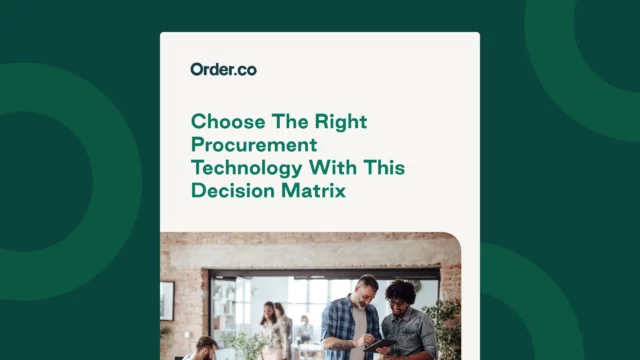The Best Tools for Integrating Procurement with Accounts Payable

The Best Tools for Integrating Procurement with Accounts Payable
Finance and operations leaders know that disconnected processes create friction, waste, and risk. When procurement and accounts payable (AP) operate in separate silos, the consequences ripple across the business: manual data entry, rogue spending, invoice overload, and a painful month-end close. For mid-market companies poised for growth, these inefficiencies are not just frustrating — they are a direct barrier to scaling effectively.
Integrating procurement with accounts payable is the solution. By connecting the entire purchase-to-pay lifecycle, you can automate workflows, gain complete spend visibility, and unlock significant cost savings. This article details the best tools for the job, from basic AP automation to comprehensive platforms that unify the entire process. Read on to explore the different types of software, the essential features to look for, and how to plan a successful integration for your business.
Download the free ebook: Choose the Right Procurement Technology With This Decision Matrix
Why is integrating procurement and accounts payable critical for mid-market companies?
Integrating procurement and accounts payable is critical because it creates a single, streamlined workflow that eliminates manual data entry, reduces costly errors, provides real-time spend visibility, and strengthens financial controls. For scaling businesses, this integration transforms a fragmented cost center into an efficient engine for growth.
Without integration, finance teams are left chasing down purchase details, manually matching invoices to purchase orders, and processing payments with incomplete information. This leads to common pain points:
- Excessive manual work: AP teams spend countless hours re-keying invoice data, hunting for approvals, and correcting errors, diverting their focus from more strategic financial activities.
- Lack of spend control: When purchasing happens outside of a controlled system, it’s nearly impossible to prevent maverick spending or enforce budgets. By the time AP sees an invoice, the money has already been spent.
- Increased risk of errors and fraud: Manual processes are prone to human error, leading to duplicate payments, overpayments, and a higher risk of invoice fraud.
- Slow processing cycles: Disconnected workflows delay approvals and payments, resulting in late payment fees and strained vendor relationships.
- Difficult financial forecasting: Without a centralized view of purchasing data, creating accurate budgets and financial forecasts is a constant challenge.
By connecting procurement and AP functions, you create a seamless purchase-to-pay process that provides complete oversight from the moment a need is identified to the final payment.
What are the types of tools for procurement and AP integration?
The primary tools for this integration range from standalone AP automation software and e-procurement platforms to fully unified procure-to-pay (P2P) systems. While all aim to improve efficiency, unified P2P platforms offer the most complete solution by managing the entire lifecycle within a single, cohesive system.
Choosing the right tool depends on identifying the root cause of your challenges. Are your problems limited to invoice processing, or do they begin with uncontrolled purchasing? Understanding this will guide you to the most effective solution.
Standalone AP automation tools
AP automation tools focus exclusively on the final stages of the P2P cycle. They use technology like optical character recognition (OCR) to digitize and centralize invoices, automate approval workflows, and streamline payment processing. Platforms like Bill.com and Tipalti are common examples in this category.
While these tools can reduce manual work within the accounts payable department, their impact is limited. They react to invoices after purchases are already made, so they do little to control spending at the source. AP teams still have to manually verify that what was invoiced matches what was ordered and received, a process that remains a significant bottleneck.
E-procurement platforms
E-procurement platforms digitize the front end of the purchasing process, including requisitions, approvals, and vendor management. Solutions like Coupa and SAP Ariba are well-known in this space, though they are often designed for large enterprises with complex needs.
These platforms provide better control over purchasing by centralizing requests and enforcing approval workflows. However, the connection to accounts payable can be disjointed. Often, AP functionality is a separate module or requires a complex integration, meaning the process is still not truly unified. Furthermore, many of these systems rely on outdated technologies like punchout catalogs, which create a clunky user experience and fail to centralize purchasing from all vendors.
Unified procure-to-pay (P2P) platforms
Unified P2P platforms provide the most comprehensive solution by managing the entire process — from sourcing and requisition to payment and reconciliation — in one system. This is the category where Order.co excels, offering a modern, end-to-end approach that other systems cannot match.
Because a unified platform captures all purchasing data at the very beginning of the process, it makes the downstream AP workflow radically simple. Approvals, product details, pricing, and general ledger (GL) codes are all captured before an order is even placed. This ensures that by the time an invoice is generated, the data is already verified, accurate, and ready for processing, eliminating the need for tedious manual checks.
Key features to look for in procurement and AP integration software
When evaluating tools, focus on features that create a truly seamless and controlled workflow. The best platforms offer a unified purchasing experience, automated workflows, centralized data management, and seamless integration with your existing financial systems.
Look for these five essential features:
- Unified purchasing marketplace: Instead of managing dozens of clunky vendor punchouts or offline catalogs, a unified marketplace brings all your vendors — online and offline — into one central place. This makes it easy for employees to find and purchase pre-approved products while allowing you to consolidate vendors and negotiate better pricing.
- Automated and customizable approval workflows: Your platform should allow you to build dynamic approval chains based on department, location, dollar amount, or project. This enforces budget compliance before an order is placed, giving you proactive control over spending.
- Centralized invoice and vendor management: The right software will drastically reduce the volume of invoices your AP team handles. Look for solutions that offer consolidated billing and automate vendor payments. A superior platform will also manage all vendor communication, including order follow-ups and issue resolution, saving your team valuable time.
- Seamless ERP and accounting system integration: A crucial feature is the tool's ability to sync clean, accurate data with your accounting system (like NetSuite, QuickBooks, or Sage Intacct). The ideal integration automatically pushes detailed invoice data into your ERP, eliminating manual data entry and ensuring your financial records are always up-to-date.
- Robust spend analytics and reporting: To make strategic decisions, you need real-time spend visibility. Choose a tool that offers detailed dashboards and reports, allowing you to analyze spending by category, vendor, department, or location. This data is essential for accurate budgeting and identifying new cost-saving opportunities.
How to plan your procurement-AP integration strategy
A successful integration starts with a clear plan. Begin by auditing your current processes to identify bottlenecks, then define specific goals for automation, evaluate tools based on those goals, and prepare your team for the change.
Follow these four steps to build your integration strategy:
- Step 1: Audit your current purchase-to-pay process. Map every step of your current workflow, from how an employee requests a product to how the vendor gets paid. Identify every manual touchpoint, delay, and source of frustration. This audit will reveal where the biggest problems lie — is it chaotic purchasing, or inefficient invoice processing?
- Step 2: Define your goals. What do you want to achieve? Make your goals specific and measurable. Examples include: "Reduce invoice processing time by 75%," "Eliminate all out-of-policy spend," or "Achieve 100% real-time visibility into indirect spend." Clear goals will help you evaluate which software is the right fit.
- Step 3: Evaluate and select the right tool. With your goals in mind, evaluate different types of tools. If your audit revealed that uncontrolled purchasing is the core issue, a standalone AP automation tool won't solve your problem. Look for a solution that addresses your specific pain points and can scale with your business. Prioritize platforms with a user-friendly interface to ensure high adoption across your organization.
- Step 4: Plan for implementation and change management. The best software is only effective if your team uses it. Involve key stakeholders from finance, procurement, and operations early in the process. Communicate the benefits clearly: less manual work, faster approvals, and easier purchasing. Choose a partner that provides robust support during implementation to ensure a smooth transition.
How Order.co unifies procurement and accounts payable
Order.co is the only procurement and finance automation platform that unifies the entire purchase-to-pay process in a guided B2B marketplace. By addressing spend at its origin — the point of purchase — Order.co makes downstream accounts payable workflows seamless, automated, and incredibly efficient.
Unlike point solutions that only solve part of the problem, Order.co connects every step of the process in a single, intelligent system.
- Purchasing starts in a controlled environment: All purchasing happens within the Order.co platform, where employees shop from a curated catalog of approved products and vendors. Budgets and approval workflows are automatically enforced, eliminating rogue spend before it happens.
- Consolidated billing simplifies invoicing: Order.co pays all your vendors directly and provides you with weekly or monthly consolidated invoices. This can reduce the number of invoices your AP team manages by over 50x, freeing them from the burden of processing hundreds of individual bills.
- Data flows seamlessly to your ERP: Because all line-item data, including GL codes, is captured and verified at the time of purchase, the information is 100% accurate. Order.co automatically pushes this clean invoice data into your ERP, eliminating manual data entry and speeding up your month-end close.
- AI-powered sourcing drives savings: The platform uses AI for procurement to automatically find cost-saving opportunities, suggesting alternative products or vendors at better prices without sacrificing quality. This helps businesses save an average of 5% on product costs.
- Full-service vendor management: Order.co becomes an extension of your team, handling all vendor communications, payments, and issue resolution. Your team never has to chase a vendor for an order update or a refund again.
Take control of your entire P2P process
Stop letting disconnected procurement and AP processes hold your business back. By integrating these functions with a unified platform, you can eliminate manual work, gain complete control over your spending, and empower your teams to focus on strategic growth. While various tools can address pieces of the puzzle, a comprehensive P2P platform like Order.co provides the end-to-end solution that scaling businesses need.
Ready to see how unifying your procurement and AP workflows can transform your financial operations? Schedule a demo to discover how Order.co can simplify buying for your business.
Get started
Schedule a demo to see how Order.co can simplify buying for your business.
"*" indicates required fields



